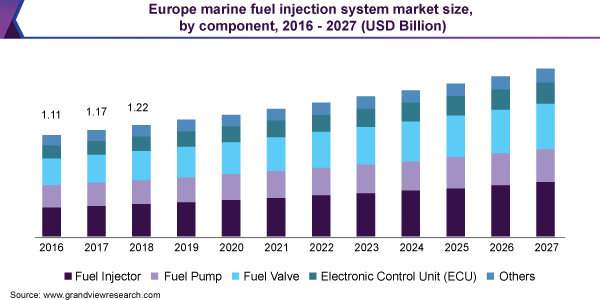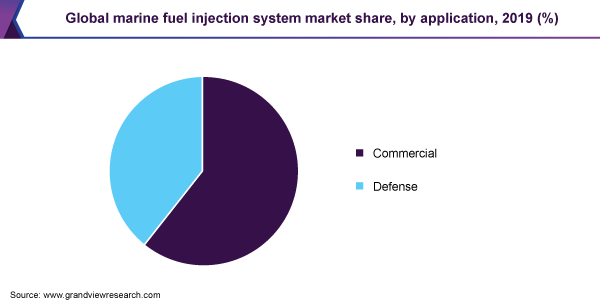- Home
- »
- Next Generation Technologies
- »
-
Marine Fuel Injection System Market Size Report, 2020-2027GVR Report cover
![Marine Fuel Injection System Market Size, Share & Trends Report]()
Marine Fuel Injection System Market Size, Share & Trends Analysis Report By Component (Fuel Injector, Fuel Pump, Fuel Valve, ECUs), By Application (Commercial, Defense), By Region, And Segment Forecasts, 2020 - 2027
- Report ID: GVR-4-68038-222-8
- Number of Report Pages: 80
- Format: PDF, Horizon Databook
- Historical Range: 2016 - 2018
- Forecast Period: 2020 - 2027
- Industry: Technology
Report Overview
The global marine fuel injection system market size was valued at USD 4.8 billion in 2019 and is expected to grow at a compound annual growth rate (CAGR) of 3.36% over the forecast period. The seaborne trade across the globe is increasing, which in turn, is driving the demand for marine fuel injection components, such as pumps and valves. Moreover, stringent government regulations pertaining to marine emissions is expected to propel the product demand.

Shipbuilders as well as component providers are investing in research and development activities to develop highly efficient products. The international trade is increasing as a result of reduced subsidies and reduced restrictions on exports and imports respectively. Importers and exporters prefer maritime transport due to higher transportation capacity and lower costs than road or rail transport.
Moreover, sea transport is more carbon-efficient than other mediums of transport. In addition, rising trend of retrofitting old ships with the latest systems and technologies is expected to have a positive impact on the products sales. Fuel injection systems form a vital part in the entire propulsion system of the ship and are responsible for maintaining the adequate fuel supply in the combustion chamber for efficient functioning of the engine.
The complex functioning of these injectors makes them prone to damage or malfunction and therefore requires frequent replacements. Thus, short lifespan of these components coupled with rapidly expanding shipping industry is expected to boost the product demand over the forecast period.
Component Insights
Based on component, the marine fuel injection system market has been segmented into injectors, pumps, valves, Electronic Control Units (ECUs), and others. The others segment includes components, such as fuel pressure regulators. The injectors segment held the largest market share in 2019. The ECU segment is projected to register significant growth over the coming years.
The ECUs regulate and alter the vital control units that include air, fuel, as well as the injection timing. The entire functioning of the ECU is based on the signals received from a series of sensors installed in it. The ECUs, therefore, play a vital role in achieving high engine performance along with reduced emissions.
Application Insights
On the basis of application, the market has been segmented into commercial and defense. The commercial segment held the largest share in 2019 and will maintain its dominance during the forecast years. Increased maritime trade across the globe is expected to boost the demand for ships and would also increase the usage of existing ships in the marine ecosystem. As a result, the product demand in the commercial segment is expected to register the highest CAGR over the forecast period.

Maritime trade accounts for around 90% of the global overseas trade due to cheap and efficient transport of fleet offered by this mode of transport. In addition, the regulatory bodies have made stringent CO2 emission policies due to which component suppliers are investing in developing efficient fuel supply components.
Regional Insights
Asia Pacific region led the market in 2019. It is anticipated to continue its dominance over the forecast period. The higher share of the region is attributed to the countries, such as China, Japan, and South Korea, as they hold majority share in the shipbuilding activities across the globe. However, due to the recent outbreak of COVID-19 has highly impacted the global economies including that of China. However, reduction in the effects of COVID-19 would involve a sudden boost in the production and therefore in the amount of exports. As a result, Chinese companies will make high use of marine transport to export goods at low costs. This is expected to have a positive impact on regional market over the forecast period.
Europe is expected to register the highest growth rate over the forecast period. The region has a major maritime tourism market across the globe, which has resulted in the increased number of ships, thereby propelling market growth. Moreover, rising popularity of watersports in this region is propelling the product demand, which in turn, boosts market growth.
Key Companies & Market Share Insights
Key companies have undertaken various strategies, such as mergers & acquisitions, partnerships, and contractual agreements, to achieve higher market share. Moreover, companies are investing in R&D activities to develop new and advanced products. For instance, in November 2018, Liebherr International AG introduced its newly designed & developed hydraulic injection components for the Chinese market. Some of the prominent players in the marine fuel injection system market include:
-
Caterpillar, Inc.
-
Rolls-Royce Plc
-
Yanmar Co. Ltd.
-
Woodward, Inc.
-
Liebherr International AG.
Marine Fuel Injection System Market Report Scope
Report Attribute
Details
Market size value in 2020
USD 5 billion
Revenue forecast in 2027
USD 6.3 billion
Growth Rate
CAGR of 3.4% from 2020 to 2027
Base year for estimation
2019
Historical data
2016 - 2018
Forecast period
2020 - 2027
Quantitative units
Revenue in USD million/billion and CAGR from 2020 to 2027
Report coverage
Revenue forecast, company ranking, competitive landscape, growth factors, and trends
Segments covered
Component, application, and region
Regional scope
North America, Europe, Asia Pacific, Latin America, and MEA
Country scope
U.S.; Canada; U.K.; Germany; France; China; India; Japan; Brazil; Mexico
Key companies profiled
Caterpillar, Inc.; Rolls-Royce Plc; Yanmar Co. Ltd.; Woodward, Inc.; and Liebherr International AG..
Customization scope
Free report customization (equivalent up to 8 analysts working days) with purchase. Addition or alteration to country, regional & segment scope.
Pricing and purchase options
Avail customized purchase options to meet your exact research needs. Explore purchase options
Segments Covered in the ReportThis report forecasts revenue growth at global, regional, and country levels and provides an analysis of the latest industry trends in each of the sub-segments from 2016 to 2027. For the purpose of this study, Grand View Research has segmented the global marine fuel injection system market report on the basis of component, application, and region:
-
Component Outlook (Revenue, USD Million, 2016 - 2027)
-
Fuel Injector
-
Fuel Pump
-
Fuel Valve
-
Electronic Control Unit (ECU)
-
Others
-
-
Application Outlook (Revenue, USD Million, 2016 - 2027)
-
Commercial
-
Passenger Cruise
-
Bulk Carrier & Container Ships
-
Tankers
-
Others
-
-
Defense
-
Submarines
-
Aircraft Carriers
-
Destroyers
-
Frigates
-
-
-
Regional Outlook (Revenue, USD Million, 2016 - 2027)
-
North America
-
The U.S.
-
Canada
-
-
Europe
-
The U.K.
-
Germany
-
France
-
-
Asia Pacific
-
China
-
India
-
Japan
-
-
Latin America
-
Brazil
-
Mexico
-
-
Middle East & Africa
-
Frequently Asked Questions About This Report
b. The global marine fuel injection system market size was estimated at USD 4.8 billion in 2019 and is expected to reach USD 5 billion in 2020.
b. The global marine fuel injection system market is expected to grow at a compound annual growth rate of 3.4% from 2020 to 2027 to reach USD 6.3 billion by 2027.
b. Fuel Injector segment dominated the marine fuel injection system market with a share of 29.2% in 2019. This is attributable to the short life span of fuel injectors as they have been observed to be the most frequently worn-out parts in the entire engine system.
b. Some key players operating in the marine fuel injection system market include Caterpillar Inc.; Rolls-Royce Plc; Yanmar Co. Ltd.; Woodward Inc.; L3 ASV; Suzuki Motor Corporation; Denso Corporation; Heinzmann GmbH & Co. KG; Cummins Inc. and Liebherr International AG.
b. Key factors that are driving the market growth include the growing seaborne trade coupled with the increased governmental regulations pertaining to marine emissions.
Share this report with your colleague or friend.
![gvr icn]()
NEED A CUSTOM REPORT?
We can customize every report - free of charge - including purchasing stand-alone sections or country-level reports, as well as offer affordable discounts for start-ups & universities. Contact us now
![Certified Icon]()
We are GDPR and CCPA compliant! Your transaction & personal information is safe and secure. For more details, please read our privacy policy.
We are committed towards customer satisfaction, and quality service.
"The quality of research they have done for us has been excellent."





